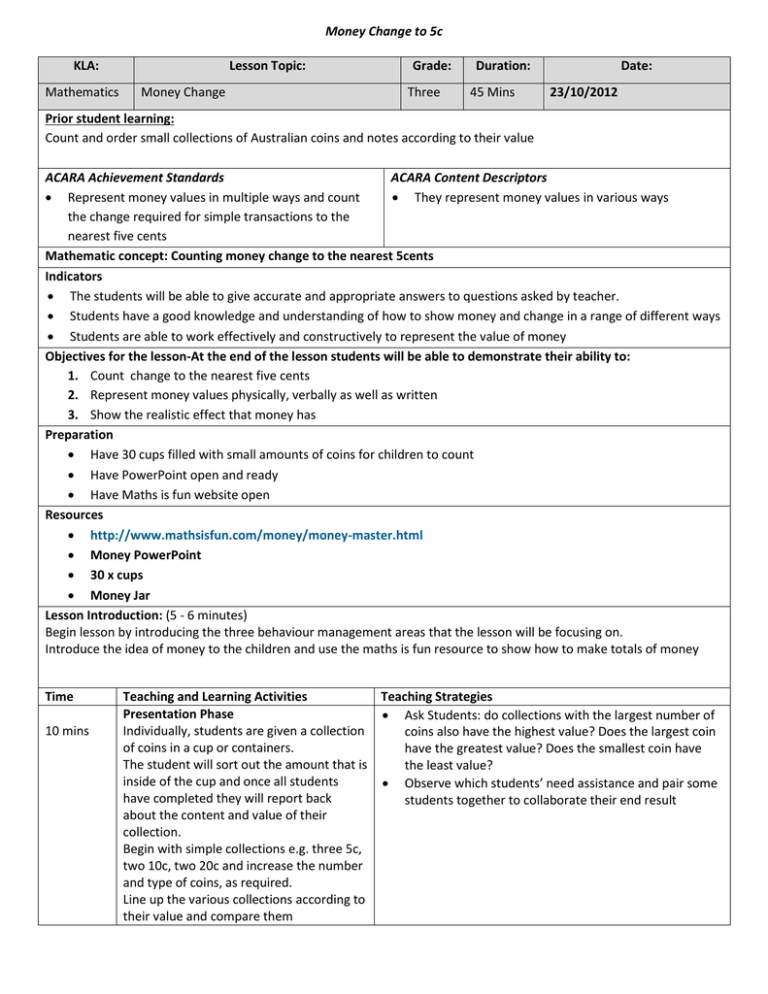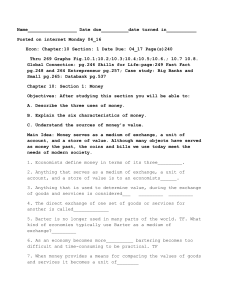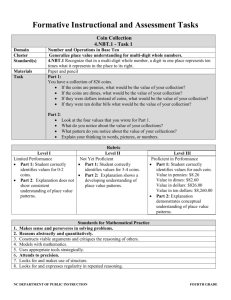Mathematics Lesson
advertisement

Money Change to 5c KLA: Mathematics Lesson Topic: Money Change Grade: Three Duration: 45 Mins Date: 23/10/2012 Prior student learning: Count and order small collections of Australian coins and notes according to their value ACARA Achievement Standards ACARA Content Descriptors Represent money values in multiple ways and count They represent money values in various ways the change required for simple transactions to the nearest five cents Mathematic concept: Counting money change to the nearest 5cents Indicators The students will be able to give accurate and appropriate answers to questions asked by teacher. Students have a good knowledge and understanding of how to show money and change in a range of different ways Students are able to work effectively and constructively to represent the value of money Objectives for the lesson-At the end of the lesson students will be able to demonstrate their ability to: 1. Count change to the nearest five cents 2. Represent money values physically, verbally as well as written 3. Show the realistic effect that money has Preparation Have 30 cups filled with small amounts of coins for children to count Have PowerPoint open and ready Have Maths is fun website open Resources http://www.mathsisfun.com/money/money-master.html Money PowerPoint 30 x cups Money Jar Lesson Introduction: (5 - 6 minutes) Begin lesson by introducing the three behaviour management areas that the lesson will be focusing on. Introduce the idea of money to the children and use the maths is fun resource to show how to make totals of money Time 10 mins Teaching and Learning Activities Teaching Strategies Presentation Phase Ask Students: do collections with the largest number of Individually, students are given a collection coins also have the highest value? Does the largest coin of coins in a cup or containers. have the greatest value? Does the smallest coin have The student will sort out the amount that is the least value? inside of the cup and once all students Observe which students’ need assistance and pair some have completed they will report back students together to collaborate their end result about the content and value of their collection. Begin with simple collections e.g. three 5c, two 10c, two 20c and increase the number and type of coins, as required. Line up the various collections according to their value and compare them 5mins Demonstration Phase Put on the “Money PowerPoint” and explain to the students that they will be looking at a lunch menu Go through the PowerPoint and constantly use the examples given to show students how to work out their remaining change as they go. 20 mins Application Phase It is completely up to them what they will buy and they only have $10.00 to spend. The only rule is that they must have at least 2 items to eat and 1 item to drink. Allow students to help work out what change is remaining before the answer is shown Ask a range of students Make sure the students are all gathered in one area and involved those who sit on the fringes Constantly walk around the room helping and observing students Challenge students by asking why they have the coins the way they have Let students try and solve their own equations using the methods shown in the PowerPoint. Allow students to try this with a range of coins and let them try the challenge twice using different foods/drinks Check Fast Finishers for extension task Lesson Conclusion Conclude the lesson by asking the students how they had gone in the challenge and what they found difficult or easy. Listen to the children’s responses to how they went in the challenge Assessment of Student Learning 1. Did the students enjoy themselves? Why/Why not? 2. Which of the students did not achieve the objectives of the lesson? 3. Were the students productive and engaged during the lesson? 4. How well did the students work in groups and as individuals? 5. What follow-up actions need to be taken in the next lesson? 6. Which students will require further support? 5mins Extended activities for fast finishers Challenge students to whoever can buy the most items for $10.00, whoever can have the most amount of change left over from buying three items and if everyone can solve the puzzle in 10 minutes Evaluation- Learning Objectives Evaluation- Self as Teacher Associate teacher’s comments:




